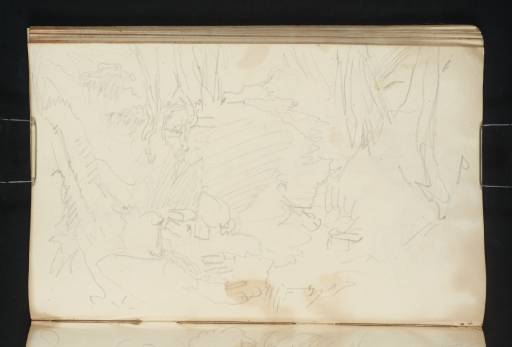J.M.W. Turner
>
1830-35 Annual tourist
>
Scotland 1834
>
Edinburgh Sketchbook
>
Artwork
Joseph Mallord William Turner Rhymer's Glen, Abbotsford 1834
Joseph Mallord William Turner,
Rhymer's Glen, Abbotsford
1834
Joseph Mallord William Turner 1775–1851
Folio 50 Verso:
Rhymer’s Glen, Abbotsford 1834
D26193
Turner Bequest CCLXVIII 50a
Turner Bequest CCLXVIII 50a
Pencil on white wove paper, 111 x 181 mm
Accepted by the nation as part of the Turner Bequest 1856
References
1909
A.J. Finberg, A Complete Inventory of the Drawings of the Turner Bequest, London 1909, vol.II, p.862, CCLXVIII 50a, as ‘Rymer’s Glen. See Engraving, Scott’s Prose Works, 1835.’.
1972
Gerald E. Finley, ‘J.M.W. Turner and Sir Walter Scott: Iconography of a Tour’, Journal of the Warburg and Courtauld Institutes, vol. 35, 1972, p.382 note 135.
1979
Andrew Wilton, J.M.W. Turner: His Life and Work, Fribourg 1979, p.432 under cat.1119.
1993
Mungo Campbell, A Complete Catalogue of Works by Turner in the National Gallery of Scotland, Edinburgh 1993, p.76 under cat.12.
1993
Dr Jan Piggott, Turner’s Vignettes, exhibition catalogue, Tate Gallery, London 1993, p.89.
This sketch was made by Turner on 3 October 1834 during a two-day excursion from Edinburgh to the Scottish Borders, undertaken to collect sketches for proposed illustrations of Scott’s works and for J.G. Lockhart’s Life of Scott.1 Having set off for Peebles on 2 October he travelled on to Innerleithen and St Mary’s Loch, continuing to Selkirk and Galashiels and then north to the Abbotsford estate, where this sketch was made. From here he proceeded to Melrose before returning to Edinburgh.
The sketch depicts Rhymer’s Glen, a wooded area on Sir Walter Scott’s Abbotsford estate near Chiefswood Cottage. Although considerably manipulated, it formed the basis of the watercolour vignette Rhymer’s Glen, Abbotsford, circa 1834 (National Gallery of Scotland),2 which was engraved by William Miller in 1835 to illustrate Scott’s Prose Works. The clue to the relationship between the sketch and final design is the small wooden bench just right of centre in the sketch, which appears more obviously in the vignette with the addition of a walking stick and a book in reference to the late poet and his works.3 At the left of the sketch is the twisting rivulet of Huntly Burn, which becomes much more prominent in the vignette, where the trees above are much denser; these may have been based on a sketch in the Abbotsford sketchbook (Tate D25934; Turner Bequest CCLXVII 4a) made during a visit in 1831. Turner must have referred to a number of different sketches of the glen to complete his design. Further views are on folios 49, 50, 51, 51 verso and 55 verso–57 (D26190, D26192, D26194, D26195, D26203–D26206).
Turner’s previous visit to the glen on 7 August 1831 was recorded in the Abbotsford sketchbook (Tate D25934–D25937; Turner Bequest CCLXVII 4a–6) and undertaken in preparation for a possible illustration to the fifth volume of Scott’s Poetical Works, Sir Tristrem. Soon after the visit, however, the subject was dropped as the choice of illustration. It was taken up again in 1834, when Turner was commissioned to paint a vignette to be engraved as the illustration to volume 21 of the Prose Works: Periodic Criticism. Gerald Finley has argued that the choice of subject was a reference to the critical achievements of Scott and his son-in-law and biographer John Gibson Lockhart, whose summer house Chiefswood is nearby (folio 52; D26196), and a reference to Scott’s critical reviews of books on landscape gardening, his interest in gardening and his practice of the Picturesque.4
There is a light brown stain at the bottom centre of the page.
Thomas Ardill
January 2011
How to cite
Thomas Ardill, ‘Rhymer’s Glen, Abbotsford 1834 by Joseph Mallord William Turner’, catalogue entry, January 2011, in David Blayney Brown (ed.), J.M.W. Turner: Sketchbooks, Drawings and Watercolours, Tate Research Publication, December 2012, https://www

